This document presents a new approach to resolving Hilbert's First Problem by utilizing Cantor's diagonal argument to define conditioned subsets of real numbers. It discusses the ongoing debate in mathematics regarding the continuum hypothesis, outlining various perspectives including finitist and pluralist viewpoints. The author proposes the formulation of a sequence-function set and its implications for understanding cardinality and establishing proper subsets of real numbers.
![A POSSIBLE RESOLUTION TO HILBERT’S FIRST
PROBLEM BY APPLYING CANTOR’S DIAGONAL
ARGUMENT WITH CONDITIONED SUBSETS OF
R, WITH THAT OF (N,R).
Rajah Iyer
Microsoft, Redmund, Seattle, USA.
ABSTRACT
We present herein a new approach to the Continuum hypothesis CH. We will employ a string conditioning,
a technique that limits the range of a string over some of its sub-domains for forming subsets K of R. We
will prove that these are well defined and in fact proper subsets of R by making use of Cantor’s Diagonal
argument in its original form to establish the cardinality of K between that of (N,R) respectively.
KEYWORDS
Diagonal Argument, Continuum Hypothesis CH, Resolution to CH
1 PREFACE
The continuum hypothesis (CH) is one of and if not the most important open problems in
set theory, one that is important for both mathematical and philosophical reasons.
Philosophically and perhaps practically, mathematicians are divided on the matter of a
resolution to CH. The uncanny persistence of the problem has led to several mainstream
views surrounding its resolution. Discussions on the possibility of a resolution, notably
one from the Institute of Advanced study at Princeton gives a vast account of the thoughts
on the problem and a detailed summary of the progress made this far, along with what may
constitute a solution see [1]. Most similar discussions express the current main sequence
thoughts on the matter, and the division that exists amongst mathematicians in the views
they hold with regard to a resolution, the nature of the resolution and what a resolution to
CH may mean. Some of the mainstream views can be summarized as follows: Finitist-
mathematicians believe that we only ever deal with the finite and as such and simply put,
we can’t really say much about the infinite. Pluralists naturally believe in the plurality of
things, that any one of the outcomes of CH is possible. Though the efforts of both Cohen
and Gödel showed the consistency of ZFC + /CH and ZFC + CH respectively, Cohen held
a strong pluralist view that his demonstration that CH cannot be decided from ZFC alone,
essentially resolved the matter. For Cohen’s independence results, See [2]. Contrary to
this however, Gödel believed that a well justified extension to ZFC was all that was neces-
sary in the way of deciding CH. Gödels program seemingly the promising option forward
aims to find an extension of ZFC axioms capable of deciding CH. Gödels Program: De-
Applied Mathematics and Sciences: An International Journal (MathSJ) Vol.10, No.1/2, June 2023
DOI : 10.5121/mathsj.2023.10203 31](https://image.slidesharecdn.com/10223mathsj03-230520045534-aabbcb55/75/A-POSSIBLE-RESOLUTION-TO-HILBERT-S-FIRST-PROBLEM-BY-APPLYING-CANTOR-S-DIAGONAL-ARGUMENT-WITH-CONDITIONED-SUBSETS-OF-R-WITH-THAT-OF-N-R-1-2048.jpg)
![cide mathematically interesting questions independent of ZFC in well justified extensions of ZFC.
Gödel himself proposed the large cardinal axioms as a candidate.
Shortly thereafter however, this extension still proved to be insufficient for the task of
deciding CH, as was demonstrated by the results of Levy and Solovay. The forcing tech-
niques employed by Cohen have since paved the way toward establishing many consis-
tency results such as the insufficiency of the large cardinal extension of ZFC in the way of
deciding CH, also by Levy and Solovay. See [3]. This however, was the starting point for
the work of W.H. Woodin demonstrating, (on the premise of large cardinals), the effective
failure of CH via use of a canonical model in which CH fails [4]. It is well known that
forcing cannot be used to decide CH, and for this primary reason, we explore here some
new ideas outside of the scope of forcing.
We must admit that these Ideas arose from Bit Conditioning, a form of conditioning digits
available to bit strings.
2 INTRODUCTION
Let us pause at this juncture to take account of the intent behind the next few paragraphs,
which is firstly to formulate a language capable of dealing with forming well defined sub-
sets of F :=
[
∀i
fi : ω< → {0,1}, (ω< is to mean a finite set of ordinals/ordered-numbers),
by restricting the range of the functions fi to 0 over arbitrary domain values of fi in
dom(fi) := ω< := {0,1,2,..,n}. Such functions ultimately constitute elements of the sets
we are interested in. Trivial but important to note is that, set of all sequences of length n
having ’conditioned segments’ is an example of a subset of F. Secondly, we aim to for-
mulate a means of establishing cardinality of such conditioned sequence sets, now however
of non-finite length, with that of SEQ :=
[
∀i
fi : N → {0,1} as a whole.
To achieve this result, we will make use of inductive arguments.
The fuzziness in the first point is best made clear with an example. Suppose we wished to
form a finite set of elements of the form
{120005,340004,710004,...}, here suggestive that each element is a 6-digit-sequence{0,..,5} →
{0,..,9} with s2 to s4 included, being always 0. Such sequences are a subset of say all se-
quences of length 6.
A simplistic language, in the mathematical sense, capable of forming precisely such con-
ditioned sequence sets will be valuable for establishing cardinality.
Returning to point two, the core diagonal argument works when one can show that for
each element in some set S, there are infinitely many more in say R2 by the argument
Diag(S,R2) (N2,R2, naturals and reals in base two). A subtle nuance is that N2 → S does
not need to be onto for the Diag argument to work. As trivial as this sounds, this is impor-
tant, for it tells us that if we are to search for a set S that exists cardinally between N2,R2
we can be certain that S ⊂ R2 and need not be onto N2, for the Diag argument to work.
If we consider the nature of how the diagonal argument is conventionally used, one ob-
serves that R is treated as comprising of all infinite sequences of the form N → {0,1}. In
fact, every element of R is representable as some infinite binary sequence R2. This almost
Applied Mathematics and Sciences: An International Journal (MathSJ) Vol.10, No.1/2, June 2023
32](https://image.slidesharecdn.com/10223mathsj03-230520045534-aabbcb55/75/A-POSSIBLE-RESOLUTION-TO-HILBERT-S-FIRST-PROBLEM-BY-APPLYING-CANTOR-S-DIAGONAL-ARGUMENT-WITH-CONDITIONED-SUBSETS-OF-R-WITH-THAT-OF-N-R-2-2048.jpg)
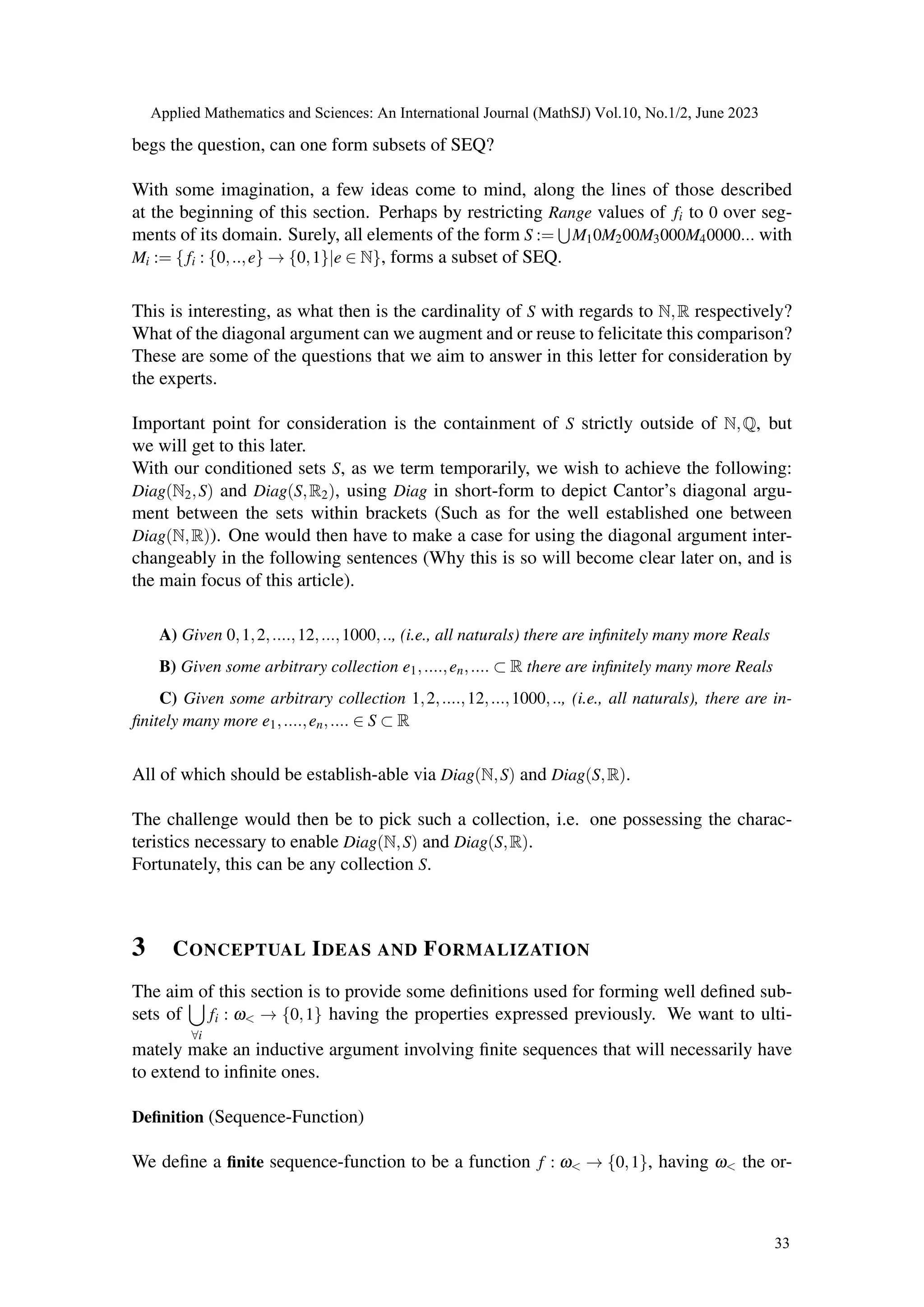
![dered set of numbers starting 0, up to some arbitrary n ∈ N,{0,..,n}, as its domain, and
range(f) := {1,0}.
Such functions, and sets thereof, are denoted by the symbols f,s, S,S′ respectively through-
out this article unless otherwise specified.
Definition (Sequence-Function Sets)
We define any set of the form S :=
[
∀i
fi : ω< → {0,1}, to be a sequence-function set,
typically denoted S,S′.
Definition (Sum)
Given an arbitrary sequence-function f, the binary operation +A on f ∈ S, is defined as
f +A f = Bnum−1(Bnum(f) + Bnum(f)), where Bnum(f) is the function Bnum(f) 7→ b ∈ B
with b being the binary number equivalent of the image of f, B the binary number set
as we have labelled it, {+} being the standard arithmetic addition operation, and Bnum−1
being the function Bnum−1(b ∈ B) 7→ (f) with b being the binary equivalent of the ordered
Image(f).
Remarks
Bnum(f)+Bnum(f) is written A2, and in general Aj for many such sums.
As an example: A2(1001) = 10010. It is to be clearly mentioned that the domain of the
function(singular) remains unaffected after Summing which strictly affects the image of f
alone.
Definition (Conditioned sub-sequence)
Given an arbitrary sequence-function f, a segment IK of the Image(f) over which Range(f) :=
{0}, for two or more domain values, is defined to be a conditioned sub-sequence.
Remarks
These are strictly partial functions fK associated with f. Both have identical domain val-
ues over IK. D(Ii),D(/Ii) respectively denote the domain sets associated with these image
intervals. Here the set D(/Ii) of domain values, are associated with all domain intervals
not associated with fK.
Definition (Length)
Given an arbitrary sequence-function, a segment-length (just length where there is no
confusion) of a random image segment sk := s[n1,n2] ∈ s ∈ S of s, with Dom(sK) = [n1,n2],
the domain interval of the the segment sK, of Image(fk), denoted by M (sK[n1,n2]), (M (sk)
where there is no confusion) is defined to mean |n2 −n1| for ni ∈ N.
Applied Mathematics and Sciences: An International Journal (MathSJ) Vol.10, No.1/2, June 2023
34](https://image.slidesharecdn.com/10223mathsj03-230520045534-aabbcb55/75/A-POSSIBLE-RESOLUTION-TO-HILBERT-S-FIRST-PROBLEM-BY-APPLYING-CANTOR-S-DIAGONAL-ARGUMENT-WITH-CONDITIONED-SUBSETS-OF-R-WITH-THAT-OF-N-R-4-2048.jpg)
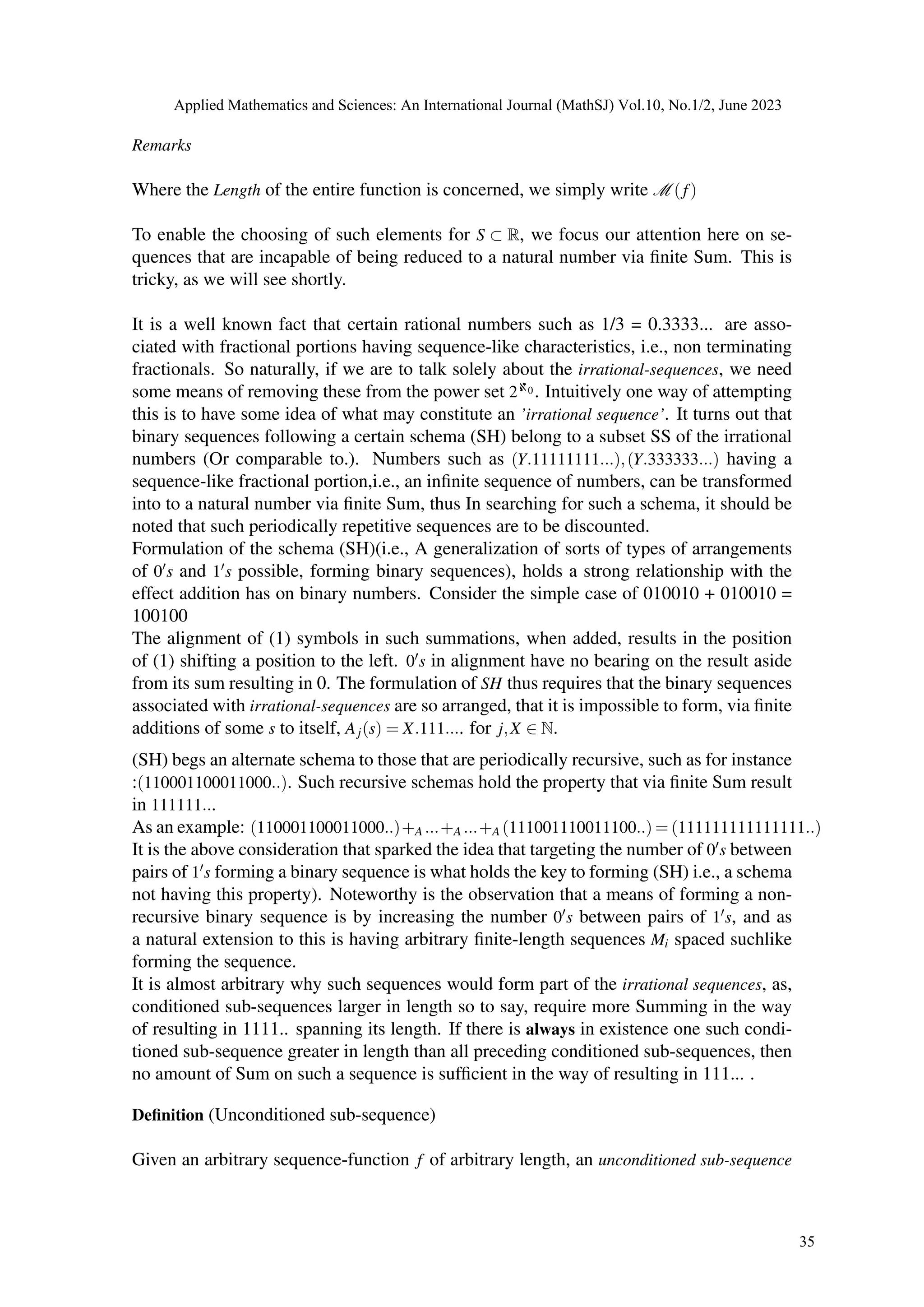
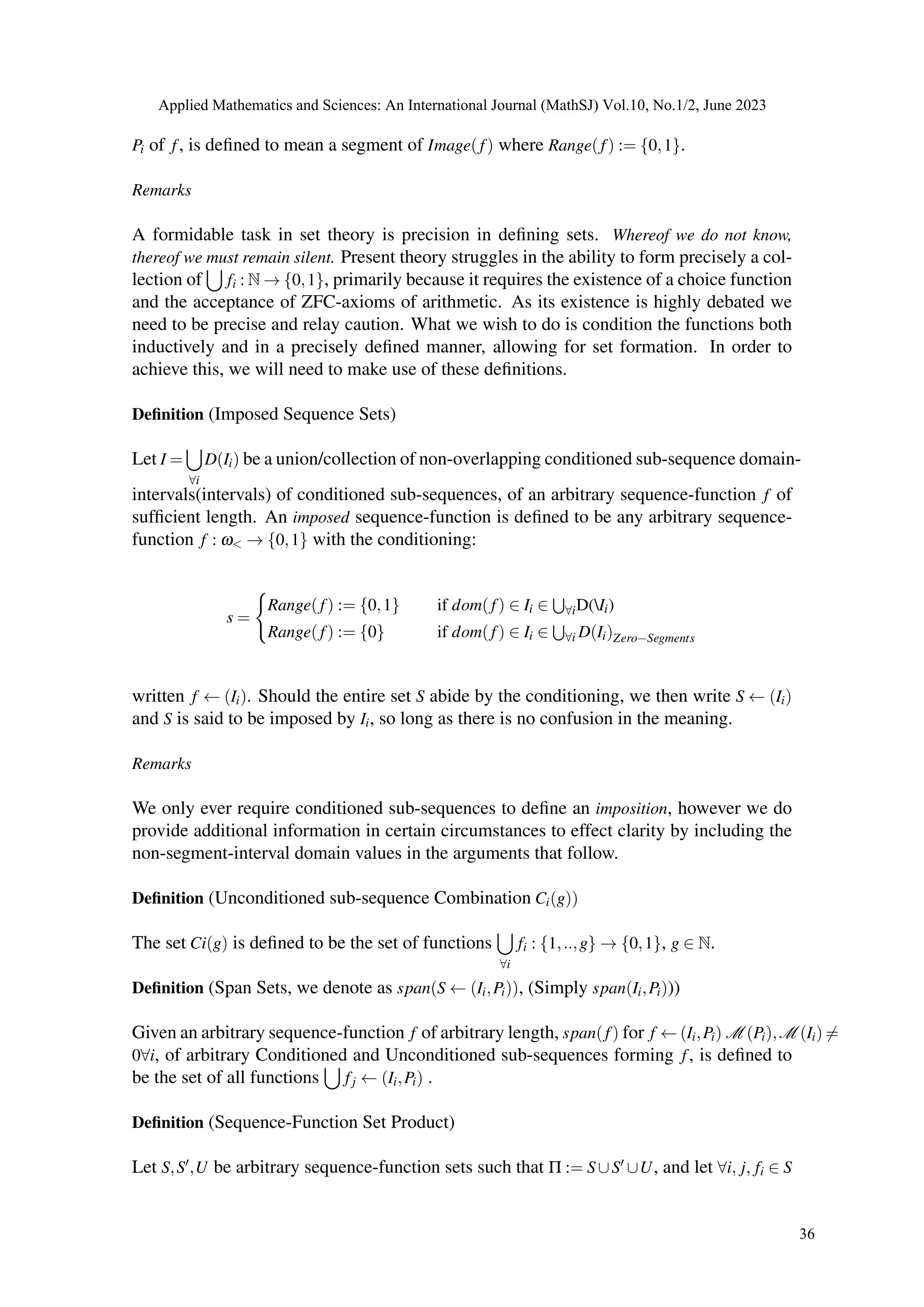
![and f′
j ∈ S′. The multiplication of (S,S′) is defined to be the binary operation Π×Π → Π :
S⊗S′ :
[
∀i,j
{fi +A f′
j} ∈ U.
Such sets are comparable to a direct product set.
Written S⊗S′, again, where S⊗S′ =U := {f1 +A f′
1, f1 +A f′
2,.., f1 +A f′
j, f2 +A f′
1, f2 +A f′
2,.., f2 +A
f′
j ... ... fi +A f′
1, fi +A f′
2,.., fi +A f′
j}
Remarks
A natural implication of span multiplication is a change in the set of conditioned sub-
sequences and unconditioned sub-sequences imposed on the resulting set.
Figure 1: The above figure illustrates a series of arbitrary elements belonging to span(S)
where S ← (Ii,Pi). Units within the grey area are indicative of the unconditioned sub-
sequences associated with each sequence depicted.
Definition (Set of Irrational Sequences)
Any set SR of all non-duplicate sequence-functions s ← (Ii,Pi) having the property M (Ii) >
M (Ii−1),∀i ∈ N, is defined to be a set of irrational sequences.
Definition (1q1,t1 )
Given an arbitrary sequence-function f ∈ S, 1q1,t1 is defined to be an unconditioned-
segment of f, P(f)[q1,t1], with 1′s spanning its length.
Lemma 0
∀s ∈ SR, no j ∈ N exists such that Aj(s) = 111....
proof
Let Iq1 [q1,t1],Iq2 [q2,t2] be arbitrary consecutive conditioned sub-sequences of s ∈ SR, if
Aj(S) results in Pq1 [q1,t1] = 1q1,t1 , then Ag(S)|g > j is required in order for Pq2 [q2,t2] to re-
sult in 1q2,t2 . Since the chosen conditioned sub-sequences in concern are arbitrary, for
infinite sequence-functions imposed in this manner, no finite set of Sums exists such that
Applied Mathematics and Sciences: An International Journal (MathSJ) Vol.10, No.1/2, June 2023
37](https://image.slidesharecdn.com/10223mathsj03-230520045534-aabbcb55/75/A-POSSIBLE-RESOLUTION-TO-HILBERT-S-FIRST-PROBLEM-BY-APPLYING-CANTOR-S-DIAGONAL-ARGUMENT-WITH-CONDITIONED-SUBSETS-OF-R-WITH-THAT-OF-N-R-7-2048.jpg)
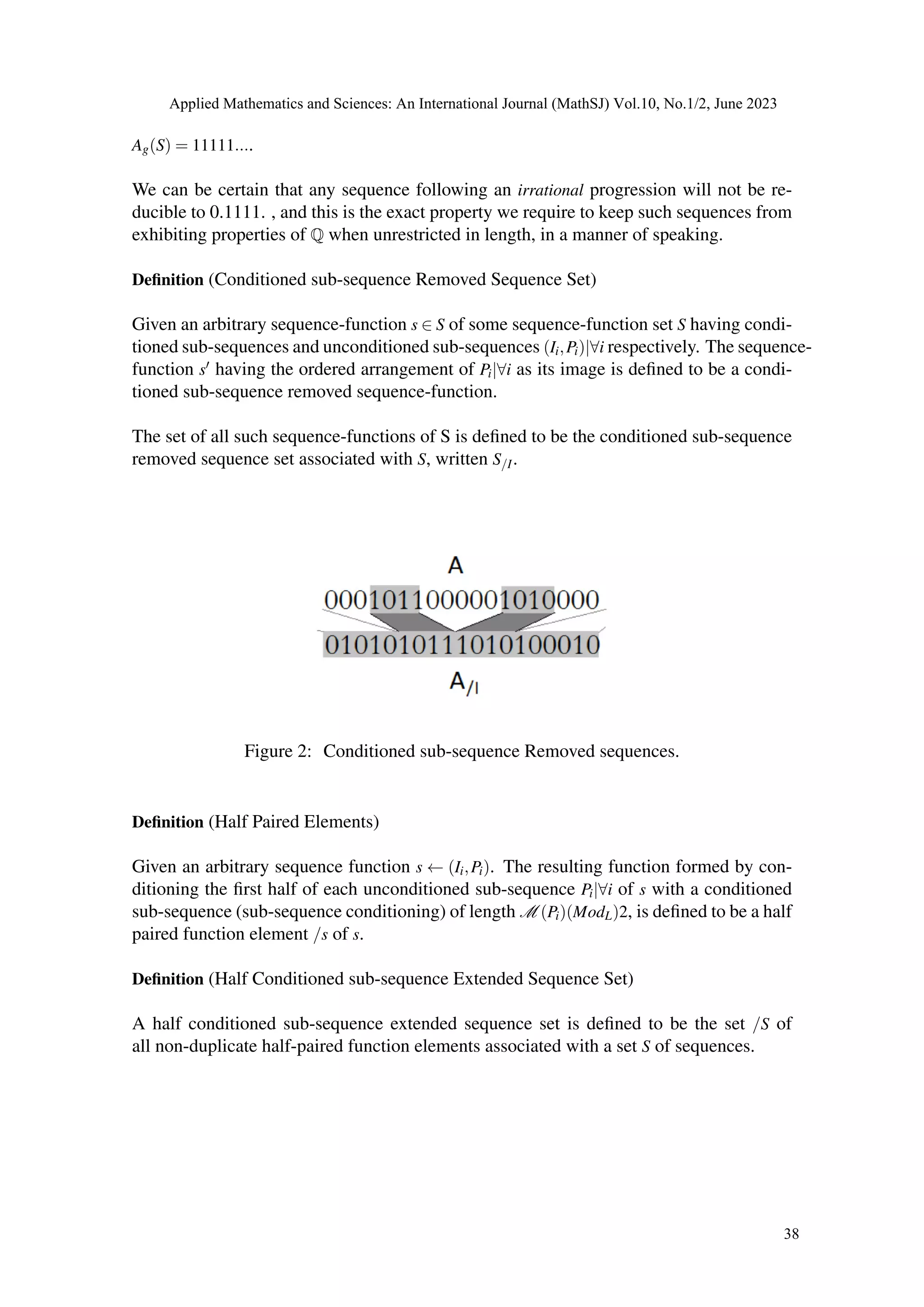
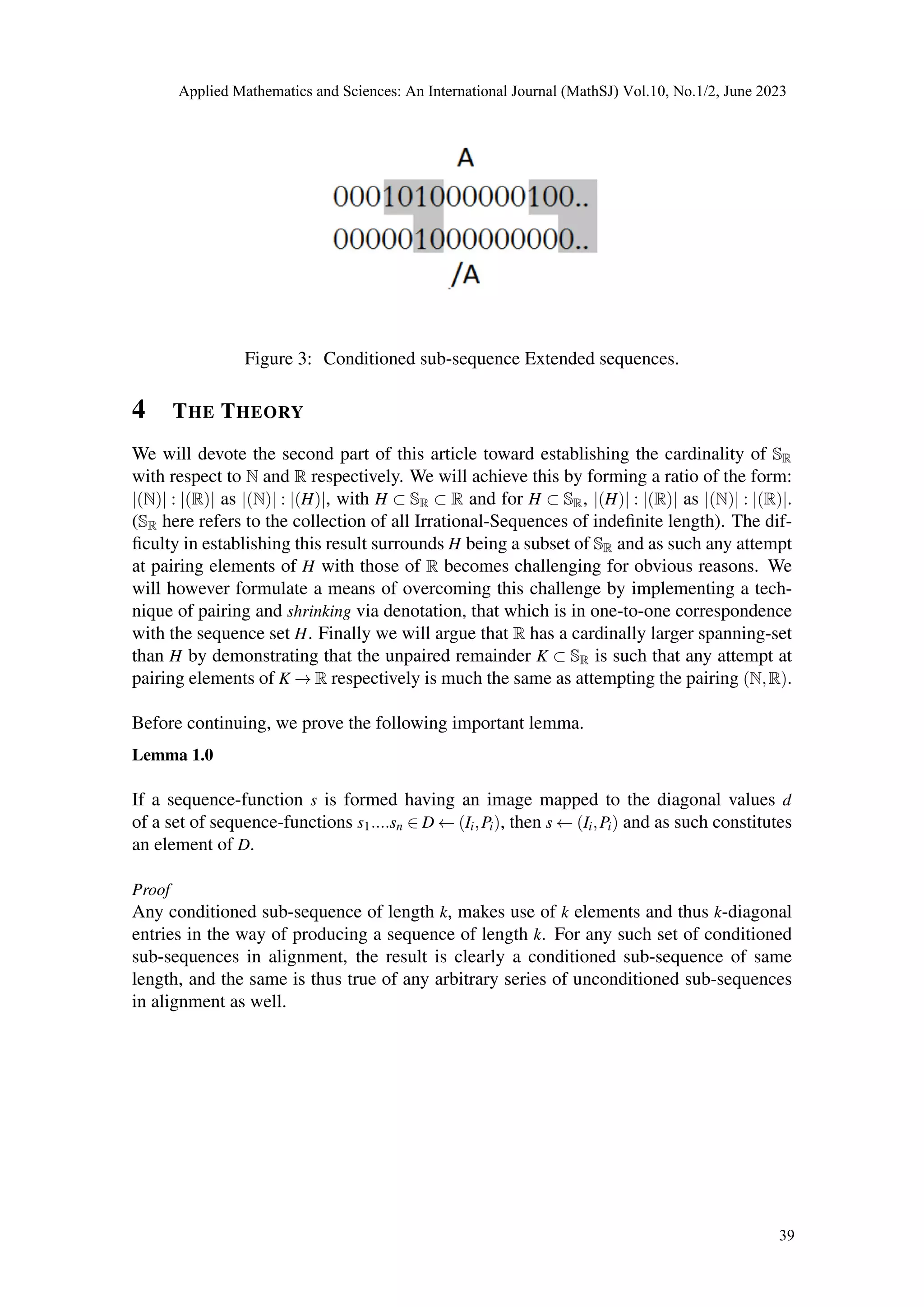
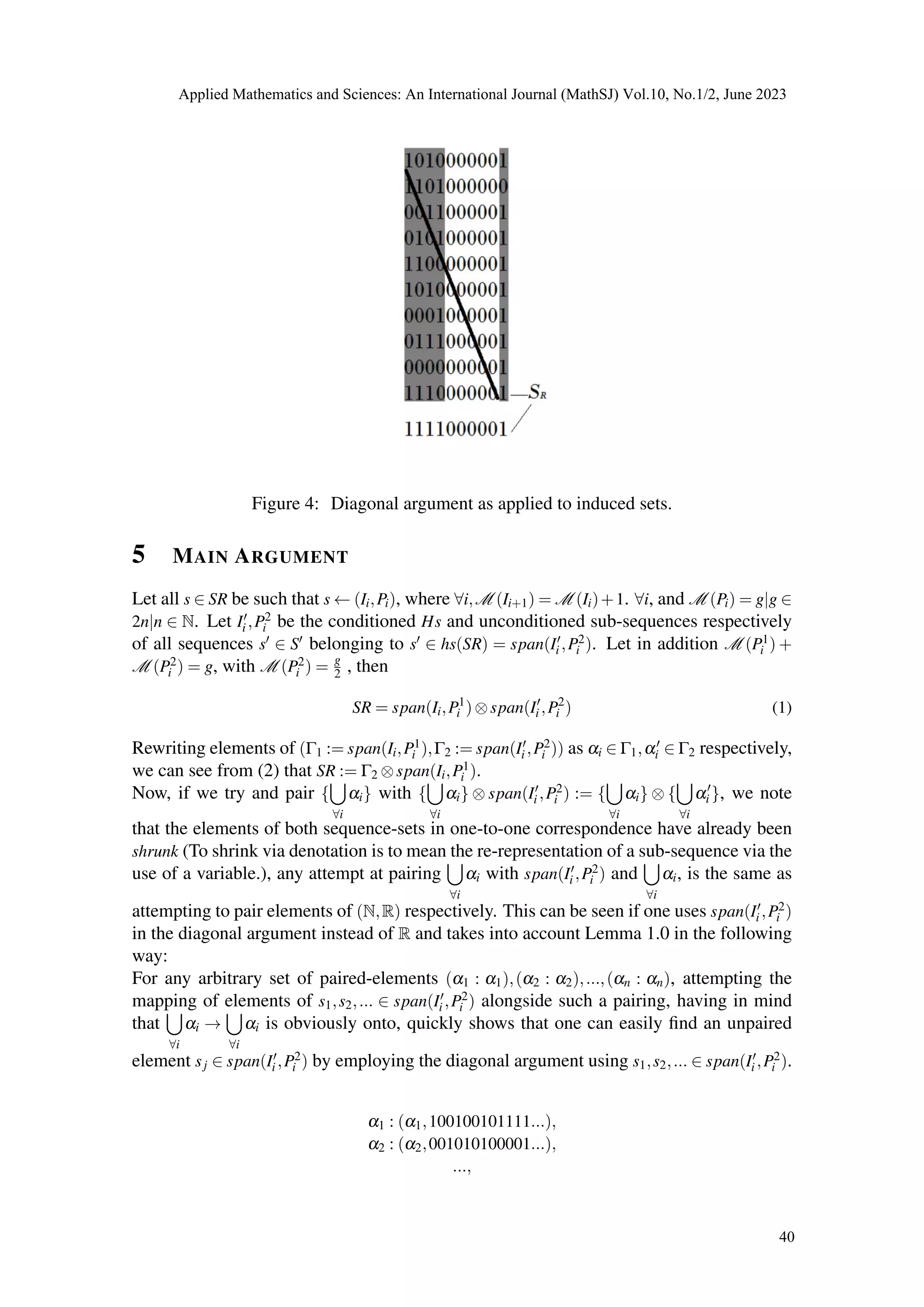
![αn : (αn,010101011110...)
(Example) An attempt at pairing Γ1 → SR.
Figure 5: Elements and Half Paired Elements.
6 CONCLUSION
As ω< is arbitrary, the previous arguments made, can be applied inductively for all ωj.
The results as such, follow in general as outlined in the introduction to the previous sec-
tion.
One can apply the diagonal argument involving (N2,SR). Since SR ⊂ R2 as already es-
tablished. This is all that needs proving in the way of establishing the cardinality of SR
between that of (N2,R2)
References
[1] Kennedy, Juliette (2011). "Can the Continuum Hypothesis be Solved?"
http://www.ias.edu/about/publications/iasletter/articles/2011-fall/
continuum-hypothesis-kennedy
[2] Cohen, Paul J. (December 15, 1963). "The Independence of the Continuum Hypoth-
esis I & II". Proceedings of the National Academy of Sciences of the United States
of America 50 (6): 1143-1148. doi:10.1073/pnas.50.6.1143. JSTOR 71858. PMC
221287. PMID 16578557 & 51 (1): 105-110. doi:10.1073/pnas.51.1.105. JSTOR
72252. PMC 300611. PMID 16591132
[3] Levy, A. and R. Solovay. "Measurable cardinals and the continuum hypothesis", Israel
Journal of Mathematics 5 (1967), 234-248.
[4] Foreman, Matt (2003). "Has the Continuum Hypothesis been Settled?" http://www.
math.helsinki.fi/logic/LC2003/presentations/foreman.pdf
[5] Gödel, K." What is Cantor’s Continuum Problem?", reprinted in Benacerraf and Put-
nam’s collection Philosophy of Mathematics, 2nd ed., Cambridge University Press,
1983. An outline of Gödel’s arguments against CH.
Applied Mathematics and Sciences: An International Journal (MathSJ) Vol.10, No.1/2, June 2023
41](https://image.slidesharecdn.com/10223mathsj03-230520045534-aabbcb55/75/A-POSSIBLE-RESOLUTION-TO-HILBERT-S-FIRST-PROBLEM-BY-APPLYING-CANTOR-S-DIAGONAL-ARGUMENT-WITH-CONDITIONED-SUBSETS-OF-R-WITH-THAT-OF-N-R-11-2048.jpg)